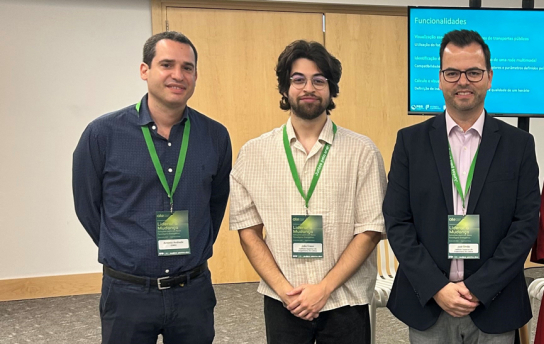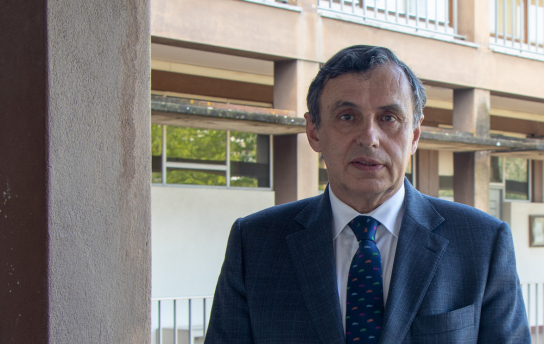ISEL welcomed 34 students under the Erasmus+ program last Wednesday, September 10th, who are now beginning their academic experience in Lisbon.Of the total participants, 15 are pursuing master's degrees and 19 are pursuing bachelor's degrees, representing 13 different nationalities: Hungary, Germany, Lithuania, Spain, Italy, Turkey, the Czech Republic, France, Belgium, Poland, the Netherlands, Brazil, and Romania.The new students will study nine different areas of study, including: Civil Engineering, Electrical Engineering, Electronic, Telecommunications, and Computer Engineering, Mechanical Engineering, Mathematics Applied to Technology and Business, Industrial Engineering and Management, Computer and Computing Engineering, Computer and Multimedia Engineering, and Chemical and Biological Engineering.The welcome session included an institutional reception, a presentation of ISEL's services, and a guided tour of the campus.
On September 10th, ISEL opened its doors to welcome the new generation of engineers, physicists, and mathematicians.ISEL President, Professor José Nascimento, welcomed them with a message of confidence and inspiration, reminding them that each student is now part of a community building the future.ISEL Vice President, Professor Carla Viveiros, presented the richness of extracurricular activities and student groups, reinforcing that the academic experience extends far beyond the classroom.ISEL Student Association President, Tomás Moscatel, brought the energy of ISEL, highlighting the cultural and athletic opportunities that make campus life vibrant and unforgettable.Between speeches, the delivery of Welcome Kits, and a campus tour, the new students were greeted with enthusiasm and motivation for a journey that combines academic excellence, personal growth, and a vibrant community.
[flickr-photoset:id=72177720328976506, size=q, num=10]Ver no flickr
ISEL Professor José Sobral (DEM/ISEL) participated in the RTP3 program 360º, representing the Portuguese Association of Engineers.His speech was part of the panel dedicated to the recent accident at the Glória Elevator, focusing on the importance of maintenance and its potential links to the incident.The nomination by the Portuguese Association of Engineers was based on his experience as a member of the College of Mechanical Engineering (South Region), his specialization in maintenance from the Association, as well as his academic and professional trajectory in this field: he has taught at ISEL for over 20 years, is a former President of the Board of Directors of the Portuguese Association of Maintenance and Asset Management (APMI), and is currently President of the General Assembly of this Association.The program can be viewed on RTP Play.
The Foundation for Science and Technology (FCT) recognizes the excellence of research developed at Lisbon Institute of Engineering (ISEL)..Several research and development (R&D) units for which ISEL is a Managing Entity or Participating Entity were recently approved for funding under the FCT's multi-year competition.ISEL is the Managing Entity for centers whose scientific output is of excellence, including the CTS - Center for Technologies and Systems (Excellent), NOVA LINCS - Laboratory for Computer Science and Informatics (Excellent), and CIMA - Center for Research in Mathematics and Applications (Excellent), as well as CeFEMA - Center for Physics and Engineering of Advanced Materials (Very Good), CFTC - Center for Theoretical and Computational Physics (Very Good), CERENA - Center for Natural Resources and Environment (Very Good), and IDL - Instituto Dom Luiz (Very Good).At the same time, ISEL is a participating entity in highly prestigious research units, such as IDMEC - Institute of Mechanical Engineering (Excellent), CQE - Center for Structural Chemistry (Very Good), and CEMAT - Center for Computational and Stochastic Mathematics (Very Good).In addition to these, the FCT also awards Excellent or Very Good ratings to other research and development (R&D) units to which ISEL faculty belong.The FCT periodically evaluates R&D units, assigning a rating that determines funding for the following multi-year period. The now-completed evaluation focused on scientific and technological activities carried out between 2018 and 2023, as well as the objectives, strategy, and activity plan defined for 2025-2029.These results reflect the commitment and quality of the research developed by ISEL faculty, researchers, and students, supported by national and international collaboration networks and strategic partnerships with industry and society.
ISEL participated in the Energy Transition Alliance (ATE) Conference at the Super Bock Arena Congress Center in Porto.Some of the 80 partners of the ATE project were present, and the "Multimodal Public Transport Management Platform" project was highlighted in the demonstration area, with a presentation of the prototype installed at Ermesinde Station and on buses managed by Maia Transportes e Carris.ISEL was represented by Professor José Simão (DEI/ISEL) and João Cravo, a Master's student in Computer Engineering and a project scholarship holder.The ATE project, in which ISEL is a partner, aims to develop a structural ecosystem that promotes a profound transformation in the energy sector, based on a concerted and multidimensional strategy for carbon neutrality, including new sustainable mobility solutions. It is expected that 60% of the investment will be in high TRL innovation, that is, technologies with a high level of maturity and the ability to be demonstrable in real use scenarios. In the image (from left to right): Professor António Andrade (IDMEC/IST), student João Cravo (ISEL), Professor José Simão (ISEL), Professor Virgínia Infante and Researcher Nuno Matos (both from (IDMEC/IST))
Professor João Gomes (DEQ/ISEL), a professor and researcher at ISEL, recently wrote an opinion piece in the newspaper Diário de Notícias, entitled "Fighting Forest Fires as a National Purpose," published in the August 27, 2025, edition.The article reflects the professor's concern about one of the biggest problems affecting the country and reinforces the academic community's contribution to the public debate surrounding forest management and fire prevention.The publication of this article in Diário de Notícias highlights the relevance of the work developed at ISEL and the active role of its professors and researchers in sharing knowledge and encouraging reflection on structural challenges facing the country.The article can be found on the Diário de Notícias website: Read the full article.






